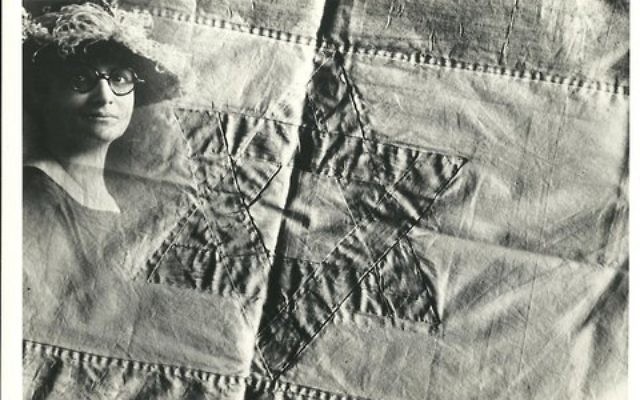The Betsy Ross of Israel
Above: Rebecca Affachiner was in her 60s when she created this flag.
By Rabbi David Geffen
Jabotinsky Street in Jerusalem is best known today for Beit HaNasi, the Israeli president’s official residence. Near it in one large complex are the Van Leer Institute and the Israel Arts and Sciences Academy.
In 1948, across from where these two buildings stand today, Rebecca Affachiner, the Betsy Ross of Israel, lived. Her patriotic act on the afternoon of May 14, after the besieged Jews of Jerusalem learned that they had their own country, has resounded for 68 years.
Who was Rebecca Affachiner? When I began to research her history 35 years ago, I was surprised to learn that in Norfolk, Va., in the early 1930s she was the adviser to my mother’s Junior Hadassah group. The January 1934 Odds and Ends, the group’s monthly paper, which my mother, Anna Birshtein Geffen, edited, bid farewell to Affachiner as she made aliyah. “We know that Miss Affachiner will make quite an impact in Palestine, G-d should bless her and the country,” my mother wrote.
In November 1999 at Emory, in what are now the Stuart A. Rose special collections, a monthlong exhibit on Affachiner was held to complement the General Assembly of Federations in Atlanta. Linda Matthews, then the director of special collections, arranged the exhibit, underwritten by the late Professor Marcella Brenner, a niece of Affachiner’s.
Rebecca, or Becky, was born in Nesvizh, Poland (now part of Belarus), in 1884. Her father, Isaac, later a founder of the Shomer Shabbat Labor Organization, went to the United States first, then brought his family in 1891. She grew up on New York’s East Side. Along with Henrietta Szold, she enrolled in the Jewish Theological Seminary of America in the first decade of the 20th century. Szold audited in the rabbinical school; Affachiner entered a teaching program and became the first woman to graduate from JTS.
On a recommendation from her close friends Chancellor Solomon Schechter and his wife, Mathilde, in 1907 she became the principal of Columbia Religious and Industrial School for Jewish Girls, an innovative educational institution in New York.
In the summer of 1918 Affachiner volunteered to be a Jewish Welfare Board war worker. Arriving in France after World War I in early 1919, Affachiner was given a JWB hut and served cookies and chocolates to several hundred Jewish soldiers each night and danced with them. She arranged the Lincoln and Washington birthday celebrations and planned and orchestrated a seder for 350. In May 1919 she welcomed the commander in chief, Gen. John J. Pershing, to the building where she worked.
For the next 14 years she was employed as an organizer for Hadassah, was the director of the Hebrew Charity Association of Hartford and became the director of Council House in Norfolk. Every summer she took a trip — Cuba, India, Mandate Palestine, Nesvizh. She was in Nazi Germany just after Hitler took over. A fervent Zionist, she made aliyah in 1934.
Early in May 1948, an American consular official knocked at the door of her apartment on Jabotinsky Street; few buildings existed there then. The official urged her to leave Jerusalem because of the expected violence.
Affachiner refused, saying she could not “abandon her brothers and sisters. I have waited my entire lifetime to see the rebirth of a Jewish state. I do not intend to miss it.”
Her dramatic act May 14, 1948, won her a permanent place in the folk annals of the new state.
Desirous of flying the Magen David, the flag of the new state (no one knew the exact flag design at that point), Affachiner had been unable to leave her apartment for two weeks because of enemy fire in the neighborhood. Never one to be thwarted, she cut up a bedsheet and sewed it into a flag with a six-pointed star and stripes. For color, she used what was at hand: a blue crayon. She waited for that historic moment.
Late on Friday afternoon, May 14, when she learned that Ben-Gurion had proclaimed the new state of Israel, Affachiner went onto her porch and raised her flag as the sun set over Jerusalem.
She died in 1966, and for the last few years of her life she was cared for by a new immigrant from Philadelphia, Ezra Gorodesky. The family chose to give him Affachiner’s flag, which has left Israel only once: when it came to Emory’s Woodruff Library in 1999 for an exhibition.
As the 70th anniversary of Israel nears in 2018, Gorodesky is seeking a permanent home for the flag. I will funnel any and all suggestions to him.
Happy Israeli Independence Day to one and all.
Rabbi David Geffen can be reached at geff706851@yahoo.com.





comments